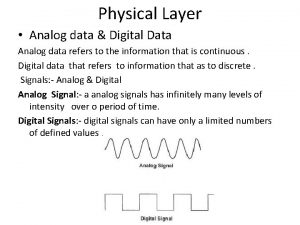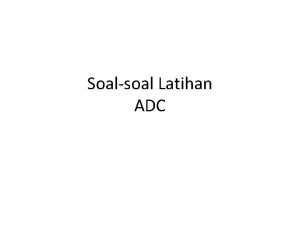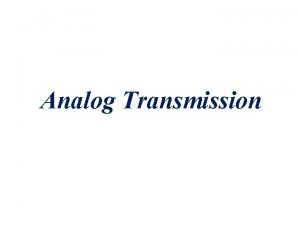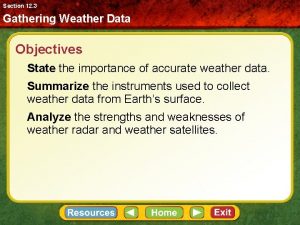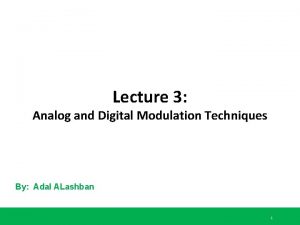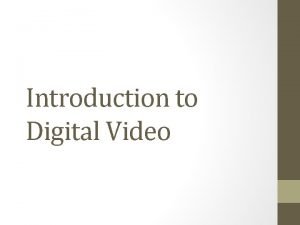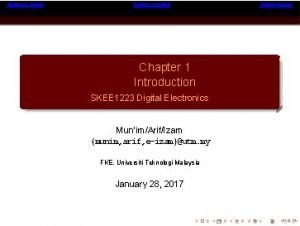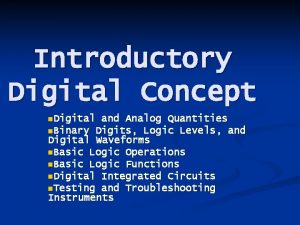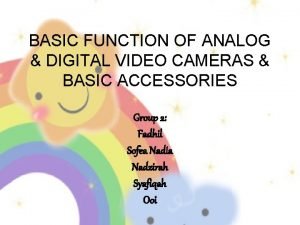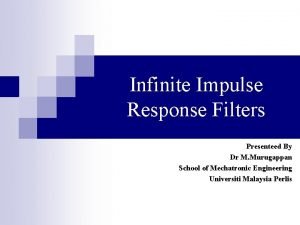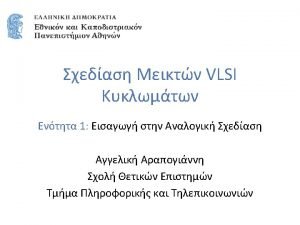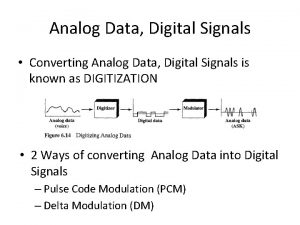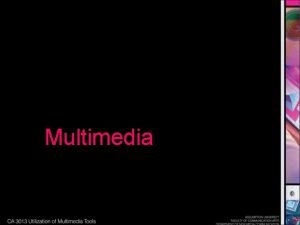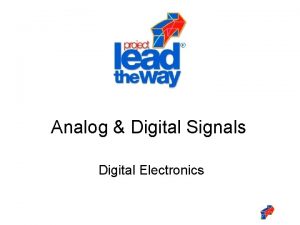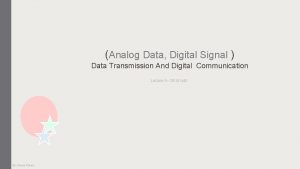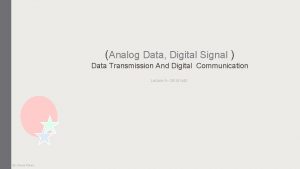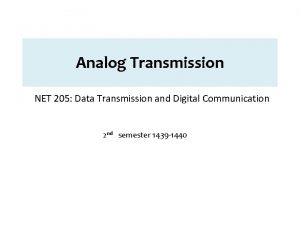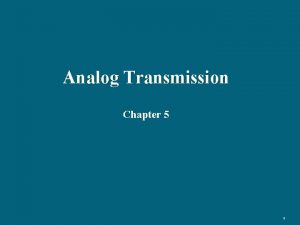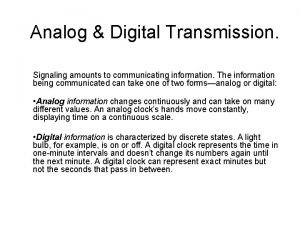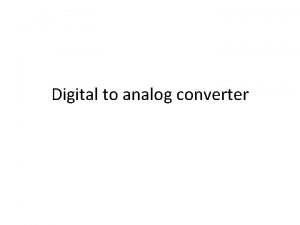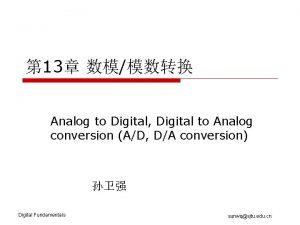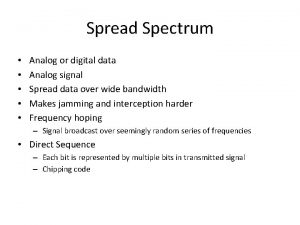Lecture Analog and Digital Transmission Data Signaling Transmission

















- Slides: 17

Lecture: Analog and Digital Transmission • Data • Signaling • Transmission • Encoding – – Digital analog Analog digital Digital digital Analog analog

Data and Signals • Analog data – Takes on continuous values. Ex. Voice or video • Digital data – Takes on discrete values. Ex. Text and integers • Analog Signal – Continuously varying electromagnetic wave representing data carried over a variety of medium • Digital Signal – Sequence of voltage pulses representing data transmitted over a wire medium

Examples • Analog to analog – Voice (Analog Data) Telephone Analog Signal • Digital to analog – PC ( Digital Data) Modem Analog Signal • Analog to digital – Voice ( Analog Data) CODEC Digital Signal • Digital to Digital – PC ( Digital Data) Digital Transmitter Digital Signal

Important Analog or Digital Data Can Be Represented By Either Analog or Digital Signals. These Signals Can Then Be Propogated (Moved Along a Medium). Optical Fiber Only Propogates Analog Signals

Reasons for Conversions • Digital data Digital Signal – Easy and simple to implement • Analog data Digital Signal – Allows the use of digital transmission and switching equipment • Digital data Analog Signal – Allows us of the public telephone system – Allows use of optical fiber • Analog Data Analog Signal – Easy – Telephone system was primarily analog

Transmission Systems • Analog Transmission – Not used with digital signal – Transmits analog signals without regard whether it represents digital or analog data – Uses amplifiers – also boosts noise – Okay for voice – Can distort digital data

Transmission Systems • Digital Transmission – Concerned with the content of the signal – Uses repeaters which recover the pattern of 0’s and 1’s and retransmits – Can be used with analog signals if it carries digital data • Again it recovers the digital data from the analog signal and generates a new clean analog signal – Is becoming more standard

Data Encoding Techniques Analog Encoding of Digital Information (cont) • Amplitude shift keying – Two binary numbers (0, 1) represented by two different amplitudes of the carrier wave – Rather inefficient – Used up to 1200 bps on voice grade lines – Used to transmit digital data over optical fiber • Frequency shift keying – Two binary numbers (0, 1) represented by two different frequencies of the carrier wave – Less susceptible to error than ASK – Used up to 1200 bps on voice grade lines – Commonly used for high frequency ( 4 to 30 mhz) radio

Data Encoding Techniques Analog Encoding of Digital Information • Phase shift keying – Two binary numbers (0, 1) represented by phase shift of the carrier wave – More efficient and noise resistant than FSK – Used up to 9600 on voice grade lines

Data Encoding Techniques Analog Encoding of Digital Information • • Techniques can be combined Common to combine phase shift and amplitude shift Can get 56 kps on a voice grade line With some techniques called multilevel signaling each signal represents more than one bit • Baud rate = signal changes per second • Bit rate = bits per second

Data Encoding Techniques Digital Encoding of Analog Information Commonly used in digitizing voice. Technique is called Pulse Code Modulation (PCM) • • – – – Sampling theory states if a signal is sampled at a rate twice the highest frequency then the samples contain all the information of the original signal Voice data in the telephone system is limited to a maximum of 4 KHz 8000 samples /sec would be sufficient Each of these samples is assigned a binary code ( 8 bits) Typically 8 bits are used which gives 256 levels

Data Encoding Techniques • Digital Encoding of Digital Information • Nonreturn–to-zero-level – Uses two different voltage levels to represent (0’s and 1’s) – Typically negative voltage =1 and positive voltage =0 – The signal never returns to zero voltage – The value during a bit time is level voltage – Short distances

Data Encoding Techniques • Digital Encoding of Digital Information • NRZI ( NRZ, invert on ones) – Constant voltage during bit time – No transition =0 – Transition form lo to hi or hi to lo =1 – Compares polarity of signals – Doesn’t matter if accidentally switch leads

Data Encoding Techniques 1. Digital Encoding of Digital Information Disadvantages of NRZ Codes 1. 2. Hard to tell where one bit ends or starts With long string of 0’s or 1’s any drift between timing of transmitter and receiver results in errors Bi-Phase Encoding 1. 2. Use at least one transition per bit time Known as self clocking codes 1. 3. 4. Predictable bit transitions during each bit time Absence of a transition indicates an error Manchester and Differential Manchester are two examples

Data Encoding Techniques Digital Encoding of Digital Information • Manchester – Transition at the middle of each bit period – Lo to hi transition=1 – Hi to lo transition =0 – Used in Ethernet and LANS

Data Encoding Techniques • Digital Encoding of Digital Information • Differential Manchester – Midbit transition is clocking only – Transition at beginning of bit period =0 – Absence of transition at beginning of bit period =1 – Used in Token Ring networks

Data Encoding Techniques • • Analog Encoding of Analog Information Can be converted directly into an analog signal Ex. Voice is represented by electromagnetic signal with same frequency components and transmitted on voice grade line Can also produce a new analog signal at higher frequency Techniques used to modulate include – AM – Amplitude Modulation – FM – Frequency Modulation – PM – Phase Modulation
 Analog and digital transmission
Analog and digital transmission Analog signla
Analog signla Rumus adc
Rumus adc Digital to analog conversion in data communication
Digital to analog conversion in data communication Compare and contrast analog and digital forecasting
Compare and contrast analog and digital forecasting Compare and contrast analog and digital forecasting
Compare and contrast analog and digital forecasting Disadvantages of fsk
Disadvantages of fsk Analog and digital video in multimedia
Analog and digital video in multimedia Digital vs analog video
Digital vs analog video Analog image and digital image
Analog image and digital image Analog and digital signals in computer networking
Analog and digital signals in computer networking Vhmin
Vhmin Digital and analog quantities
Digital and analog quantities Introduction to analog and digital control systems
Introduction to analog and digital control systems Analog vs digital video
Analog vs digital video Impulse invariant method formula
Impulse invariant method formula Introduction to digital control system
Introduction to digital control system Razavi cmos analog circuit design
Razavi cmos analog circuit design

